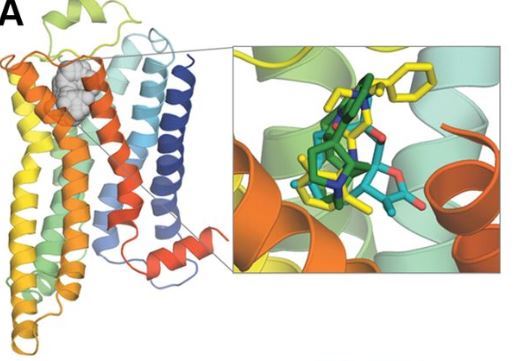Introduction of TAS2R10
TAS2R10 (Taste receptor type 2 member 10), a G protein-coupled receptor, is encoded by TAS2R10 gene. The protein specifically expresses in the receptor cells of the tongue and palatal epithelium. It clusters in the genome and links to loci that influence pain perception in mice and humans. TAS2R10 can respond to bitter substances. Many studies conducted in TAS2R10 reveal that it is a promising potential target of bronchodilation.
| Basic Information of TAS2R10 | |
| Protein Name | Taste receptor type 2 member 10 |
| Gene Name | TAS2R10 |
| Aliases | T2R10, TRB2 |
| Organism | Homo sapiens (Human) |
| UniProt ID | Q9NYW0 |
| Transmembrane Times | 7 |
| Length (aa) | 307 |
| Sequence |
MLRVVEGIFIFVVVSESVFGVLGNGFIGLVNCIDCAKNKLSTIGFILTGLAISRIFLIWI IITDGFIQIFSPNIYASGNLIEYISYFWVIGNQSSMWFATSLSIFYFLKIANFSNYIFLW LKSRTNMVLPFMIVFLLISSLLNFAYIAKILNDYKTKNDTVWDLNMYKSEYFIKQILLNL GVIFFFTLSLITCIFLIISLWRHNRQMQSNVTGLRDSNTEAHVKAMKVLISFIILFILYF IGMAIEISCFTVRENKLLLMFGMTTTAIYPWGHSFILILGNSKLKQASLRVLQQLKCCEK RKNLRVT |
Function of TAS2R10 Membrane Protein
The TAS2R10 receptor can express in the smooth muscle of human airways and non-gustatory tissues, which indicates that it plays an important role in many other functions except taste perception. Meanwhile, recent studies on the TAS2R10 receptor show it responds to the toxic strychnine and numerous other compounds, which indicates it serves as a disease-related receptor in the human body. In addition, the higher levels of TAS2R10 expression is found in more differentiated SY5Y cells, which suggests that TAS2R10 may be related with neuroblastoma (NB). The further study shows that the over-expression of TAS2R10 inhibits cell migration, cell invasion, and matrix metalloproteinases activity of tumor. Besides, TAS2R10 targets cancer stem cells by suppressing cancer stemness characteristics. It could be a biomarker in clinical therapy.

Application of TAS2R10 Membrane Protein in Literature
This article analyses the expression level of TAS2R8 and TAS2R10 in SK-N-BE(2)C and SH-SY5Y cells, and results indicate that TAS2Rs target stem cells by inhibiting carcinogenic characteristics and NB cell invasion, thus improving the chemotherapeutic potential of bitter receptors.
This article investigates whether the mRNA expression of bitter receptors (TAS2R4, TAS2R10, TAS2R38, TAS2R43, and TAS2R46) is related to individual bitterness intensity and habitual consumption of bitter beverages. The result indicates that there is a strong association between TAS2R gene expression and individual differences in caffeine perception.
Authors select nine porcine TAS2R genes to identify variability, and they analyze SNP allele frequencies in several populations. A total of 125 SNPs are identified, and some of them can affect the function of bitter taste receptors, which is important to understand the complexity of taste perception.
This article reports the agonists which can activate Tas2R10 residues and the effects of different substituents on receptor's response profile.
The authors examine the TAS2R mRNA expression on guinea pig trachea (GPT) epithelium and smooth muscle, and to identify effects of bitter taste agonists on responses induced by different contractile mediators. The result shows TAS2Rs are potential targets of bronchodilation agonists.
TAS2R10 Preparation Options
To obtain the soluble and functional target protein, the versatile Magic™ membrane protein production platform in Creative Biolabs enables many flexible options, from which you can always find a better match for your particular project. Aided by our versatile Magic™ anti-membrane protein antibody discovery platform, we also provide customized anti-TAS2R10 antibody development services.
As a forward-looking research institute as well as a leading custom service provider in the field of membrane protein, Creative Biolabs has won good reputation among our worldwide customers for successfully accomplishing numerous challenging projects including generation of many functional membrane proteins. Please feel free to contact us for more information.
Reference
All listed services and products are For Research Use Only. Do Not use in any diagnostic or therapeutic applications.